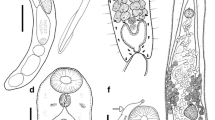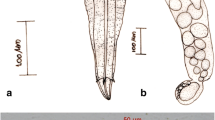Abstract
Previously unknown gymnophallid parthenogenetic metacercariae (PM), referred to as Cercaria falsicingulae I larva nov., were found in the extrapallial cavities of the snails Falsicingula mundana (Yokoyama) and F. athera (Bartsch) on coasts of Sakhalin and the Kuril Islands. Unlike all other known PM, rather than producing metacercariae infective to the definitive host, their furcocercariae emerge into the environment. The developing cercariae and metacercariae of C. falsicingulae I are described and compared with other gymnophallid larvae from littoral molluscs in the region. Experimental evidence and analysis of metacercarial group composition in naturally infected molluscs indicate that some cercariae leave their molluscan hosts and penetrate other specimens of Falsicingula in which they develop into new cercariae-producing PM. Metacercariae with developing hermaphroditic reproductive organs were never observed in naturally infected molluscs. A probable life-cycle for C. falsicingulae I is presented in which cercarial/metacercarial production is switched seasonally in order to enable the infection of the definitive hosts by PM. Importantly, the ‘cercaria – PM – cercaria’ component of the life-cycle appears to be somewhat autonomous.



Similar content being viewed by others
References
Bayne, C. J., & Grevelding, C. G. (2003). Cloning of Schistosoma mansoni sporocysts in vitro and genetic heterogeneity among individuals within clones. Journal of Parasitology, 89, 1056–1060.
Ching, H. L. (1982). Description of germinal sacs of a gymnophallid trematode, Cercaria margaritensis sp. n., in the extrapallial fluid of subtidal snails (Margarites spp.) in British Columbia. Canadian Journal of Zoology, 60, 516–520.
Chubrik, G. K. (1966). Fauna and ecology of trematode larvae from molluscs of the Barents and White Seas. In Yu. I. Poljansky (Ed.), Life cycles of parasitic worms from northern seas (pp. 78–159). Leningrad: Nauka (In Russian).
Deblock, S. (1980). Inventaire des trématodes larvaires parasites des mollusques Hydrobia (Prosobranches) des côtes de France. Parassitologia, 22, 1–105.
Galaktionov, K. V. (1996). An experimental study of the unusual life cycle of Parvatrema sp. (Trematoda: Gymnophallidae). Parazitologiya, 30, 487–494 (In Russian).
Galaktionov, K. V., Irwin, S. W. B., & Saville, D. H. (2006). One of the most complex life cycles among digenetic trematodes: a description of Parvatrema margaritense (Ching, 1982) n. comb. (Gymnophallidae) possessing parthenogenetic metacercariae. Parasitology, 132, 733–746.
Grevelding, C. G. (2003). Genomic instability in Schistosoma mansoni. Molecular and Biochemical Parasitology, 101, 207–216.
James, B. L. (1964). The life cycle of Parvatrema homoeotecnum sp. nov. (Trematoda: Digenea) and review of the family Gymnophallidae Morozov, 1955. Parasitology, 54, 1–41.
Loos-Frank, B. (1969). Zur Kenntnis der gymnophalliden Trematoden des Nordseeraumes. I. Die Alternativ-Zyklen von Gymnophallus choledochus. Zeitschrift für Parasitenkunde, 32, 135–156.
Poulin, R., & Cribb, T. H. (2002). Trematode life cycles: short is sweet? Trends in Parasitology, 18, 176–183.
Reimer, L. W. (1970). Digene Trematoden und Cestoden der Ostseefishe als natürliche Fischmarken. Parasitologische Schriftenreihe, 20, 1–144.
Scholz, T. (2002). Family Gymnophallidae Odhner, 1905. In D. I. Gibson, A. Jones, & R. A. Bray (Eds.), Keys to the Trematoda (Vol 1, pp. 245–251). London: CABI Publishing and the Natural History Museum.
Semyenova, S. K., Khrisanfova, G. G., Filippova, E. K., Be’er, S. A., Voronin, M. V., & Riskov, A. P. (2005). Individual and populational variability of schistosomid cercariae of Trichobilharzia ocellata group (Trematoda, Schistosomatidae) revealing using PCR. Genetica, 41, 17–22 (In Russian).
Szidat, L. (1962). Über eine ungewöhnliche Form parthenogenetischer Vermehrung bei Metacercarien einer Gymnophallus-Art aus Mytilus platensis, Gymnophallus australis n. sp. Des Südatlantik. Zeitschrift für Parasitenkunde, 22, 196–213.
Tsimbaljuk, A. K., Kulikov, V. V., & Baranova, T. I. (1978). Helminths of invertebrates from the intertidal zone of the Iturup island. In O. G. Kusakin (Ed.), Fauna and vegetation of the shelf of the Kuril islands (pp. 69–126). Moscow: Nauka (In Russian).
Wilke, T., & Davis, G. M. (2000). Infraspecific mitochondrial sequence diversity in Hydrobia ulvae and Hydrobia ventrosa (Hydrobiidae: Rissooidea, Gastropoda): Do their different life histories affect biogeographic patterns and gene flow? Biological Journal of the Linnean Society, 70, 89–105.
Acknowledgements
I thank Dr S. W. B. Irwin for his comments and the correction of the English and Dr D. I. Gibson for the editing of the manuscript. I am also indebted to two anonymous reviewers for their comments on the manuscript. Special thanks are also due to Dr K. V. Regel and Dr G. I. Atrashkevich for their valuable help during the fieldwork. The project was financed by grants from the RFBR and INTAS.
Author information
Authors and Affiliations
Corresponding author
Rights and permissions
About this article
Cite this article
Galaktionov, K.V. A description of the parthenogenetic metacercaria and cercaria of Cercaria falsicingulae I larva nov. (Digenea: Gymnophallidae) from the snails Falsicingula spp. (Gastropoda), with speculation on an unusual life-cycle. Syst Parasitol 68, 137–146 (2007). https://doi.org/10.1007/s11230-007-9097-3
Received:
Accepted:
Published:
Issue Date:
DOI: https://doi.org/10.1007/s11230-007-9097-3




